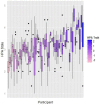Network Diversity and Affect Dynamics: The Role of Personality Traits
- PMID: 27035904
- PMCID: PMC4817969
- DOI: 10.1371/journal.pone.0152358
Network Diversity and Affect Dynamics: The Role of Personality Traits
Abstract
People divide their time unequally among their social contacts due to time constraints and varying strength of relationships. It was found that high diversity of social communication, dividing time more evenly among social contacts, is correlated with economic well-being both at macro and micro levels. Besides economic well-being, it is not clear how the diversity of social communication is also associated with the two components of individuals' subjective well-being, positive and negative affect. Specifically, positive affect and negative affect are two independent dimensions representing the experience (feeling) of emotions. In this paper, we investigate the relationship between the daily diversity of social communication and dynamic affect states that people experience in their daily lives. We collected two high-resolution datasets that capture affect scores via daily experience sampling surveys and social interaction through wearable sensing technologies: sociometric badges for face-to-face interaction and smart phones for mobile phone calls. We found that communication diversity correlates with desirable affect states--e.g. an increase in the positive affect state or a decrease in the negative affect state--for some personality types, but correlates with undesirable affect states for others. For example, diversity in phone calls is experienced as good by introverts, but bad by extroverts; diversity in face-to-face interaction is experienced as good by people who tend to be positive by nature (trait) but bad for people who tend to be not positive by nature. More broadly, the moderating effect of personality type on the relationship between diversity and affect was detected without any knowledge of the type of social tie or the content of communication. This provides further support for the power of unobtrusive sensing in understanding social dynamics, and in measuring the effect of potential interventions designed to improve well-being.
Conflict of interest statement
Figures





Similar articles
-
Beyond Contagion: Reality Mining Reveals Complex Patterns of Social Influence.PLoS One. 2015 Aug 27;10(8):e0135740. doi: 10.1371/journal.pone.0135740. eCollection 2015. PLoS One. 2015. PMID: 26313449 Free PMC article.
-
What Differences Make a Difference? The Promise and Reality of Diverse Teams in Organizations.Psychol Sci Public Interest. 2005 Oct;6(2):31-55. doi: 10.1111/j.1529-1006.2005.00022.x. Epub 2005 Oct 1. Psychol Sci Public Interest. 2005. PMID: 26158478
-
Homophily in an Anonymous Online Community: Sociodemographic Versus Personality Traits.Cyberpsychol Behav Soc Netw. 2017 Jun;20(6):376-381. doi: 10.1089/cyber.2016.0227. Epub 2017 May 12. Cyberpsychol Behav Soc Netw. 2017. PMID: 28497997
-
[Charisma].Orv Hetil. 2008 Oct 12;149(41):1937-41. doi: 10.1556/OH.2008.28465. Orv Hetil. 2008. PMID: 18842511 Review. Hungarian.
-
The Role of Interpersonal Traits in Social Decision Making: Exploring Sources of Behavioral Heterogeneity in Economic Games.Pers Soc Psychol Rev. 2015 Aug;19(3):277-302. doi: 10.1177/1088868314553709. Epub 2014 Dec 31. Pers Soc Psychol Rev. 2015. PMID: 25552474 Review.
Cited by
-
Is having an educationally diverse social network good for health?Netw Sci (Camb Univ Press). 2020 Sep;8(3):418-444. doi: 10.1017/nws.2020.14. Epub 2020 May 11. Netw Sci (Camb Univ Press). 2020. PMID: 32944241 Free PMC article.
-
Sensor-based proximity metrics for team research. A validation study across three organizational contexts.Behav Res Methods. 2021 Apr;53(2):718-743. doi: 10.3758/s13428-020-01444-x. Behav Res Methods. 2021. PMID: 32813224 Free PMC article.
-
Reflecting on Dunbar's numbers: Individual differences in energy allocation to personal relationships.PLoS One. 2025 Mar 11;20(3):e0319604. doi: 10.1371/journal.pone.0319604. eCollection 2025. PLoS One. 2025. PMID: 40067868 Free PMC article.
-
Development and evaluation of Dona, a privacy-preserving donation platform for messaging data from WhatsApp, Facebook, and Instagram.Behav Res Methods. 2025 Feb 14;57(3):94. doi: 10.3758/s13428-024-02593-z. Behav Res Methods. 2025. PMID: 39951233 Free PMC article.
-
Diversity in Social Communication and Support: Implications for Loneliness Among LGB Adults.Gerontologist. 2023 Feb 25;63(2):361-372. doi: 10.1093/geront/gnac101. Gerontologist. 2023. PMID: 35863035 Free PMC article.
References
-
- Madan A, Cebrian M, Lazer D, Pentland A. Social sensing for epidemiological behavior change In: Proceedings of the 12th ACM international conference on Ubiquitous computing. ACM; 2010. p. 291–300. 10.1145/1864349.1864394 - DOI
-
- Cohen S, Doyle WJ, Skoner DP, Rabin BS, Gwaltney JM. Social ties and susceptibility to the common cold. Jama. 1997;277(24):1940–1944. - PubMed
-
- Putnam RD. E pluribus unum: Diversity and community in the twenty-first century the 2006 Johan Skytte Prize Lecture. Scandinavian political studies. 2007;30(2):137–174. 10.1111/j.1467-9477.2007.00176.x - DOI
-
- Villalpando O. The impact of diversity and multiculturalism on all students: Findings from a national study. Journal of Student Affairs Research and Practice. 2002;40(1):124–144. 10.2202/1949-6605.1194 - DOI
Publication types
MeSH terms
LinkOut - more resources
Full Text Sources
Other Literature Sources
Medical
Research Materials
Miscellaneous

